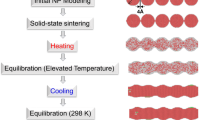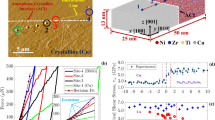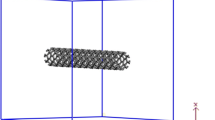Abstract
Nanoparticle chain aggregates (NCA) serve as reinforcing fillers that are combined with molecular polymers to produce nano-composite materials, e.g. carbon black in rubber. The reinforcing mechanism due to the incorporation of nanoparticle aggregates is not well understood. Molecular dynamics (MD) computer simulations are employed to investigate the behavior of nanoparticle chain aggregates under strain. The interaction potential used is that of Cu obtained with the embedded atom method (EAM). Three single-crystal Cu nanoparticles are placed in contact in two different configurations (linear and kinked) and the structures are initially relaxed with MD steps for 300 ps. We observe plastic deformation during the sintering process for very small particles (∼2.5 nm in diameter) at temperatures as low as 300 K. The relaxed configurations are then strained to the breaking point at strain rates in the order of 1 m/s. We identify mechanisms of strain accommodation that lead to nanoparticle plastic deformation and eventually fracture. The linear and the kinked configurations break at strains of 0.263 and 0.344 respectively, while the maximum stress is close to 4 GPa (strain rate: 0.625 m/s). Both structures fail at the low-angle grain boundaries developed during the sintering process, while the higher strain for fracture for the kinked configuration is associated with interface sliding not observed in the linear case.
Similar content being viewed by others
References
G. Heinrich, M. Klüppel and T. A. Viglis, Curr. Opin. Solid St. M. 6, 195 (2002).
J. E. Mark, J. Phys. Chem. B 107, 903 (2003).
A. I. Medalia and G. Kraus in Science and Technology of Rubber 2nd ed., edited by J. E. Mark, B. Erman and F. R. Eirich, (Academic Press, 1994) pp. 387–418.
Z. Pu, J. E. Mark, J. M. Jethmalani and W. T. Ford, Chem. Mater. 9, 2442 (1997).
D. J. Kohls, G. Beaucage, Curr. Opin. Solid St. M. 6, 183 (2002).
M. Gerspacher, C. P. O’Farrell, Kaut. Gummi Kunstst. 54, 153 (2001).
T. A. Witten, M. Rubinstein and R. H. Colby, J. Phys. II France 3, 367 (1993).
S. K. Friedlander, H.D. Jang, K. H. Ryu, Appl. Phys. Lett. 72, 173 (1998).
K. Ogawa, T. Vogt, M. Ullmann, S. Johnson and S. K. Friedlander, J. Appl. Phys. 87, 63 (2000).
Y. J. Suh and S. K. Friedlander, J. Appl. Phys. 93, 3515 (2003).
S. K. Friedlander, K. Ogawa, M. Ullmann, J. Polym. Sci. Pol. Phys. 38, 2658 (2000).
S.M. Foiles, M. I. Baskes and M. S. Daw, Phys. Rev. B 33, 7983 (1986).
The EAM parameterization used was that of D. J. Oh and R. A. Johnson, J. Mater. Res. 3, 471 (1988).
U. Landman, W. D. Luedtke, N. A. Burnham, R. J. Colton, Science 248, 454 (1990).
H. Zhu and R. S. Averback, Phil. Mag. Lett. 73, 27 (1996).
P. Zeng, S. Zalac, P. C. Clapp, J.A. Rifkin, Mater. Sci. Eng. A 252, 301 (1998).
Author information
Authors and Affiliations
Rights and permissions
About this article
Cite this article
Dalis, A.S., Friedlander, S.K. The Behavior of Copper Nanoparticle Chain Aggregates Under Strain – A Molecular Dynamics Approach. MRS Online Proceedings Library 778, 98 (2003). https://doi.org/10.1557/PROC-778-U9.8
Published:
DOI: https://doi.org/10.1557/PROC-778-U9.8




